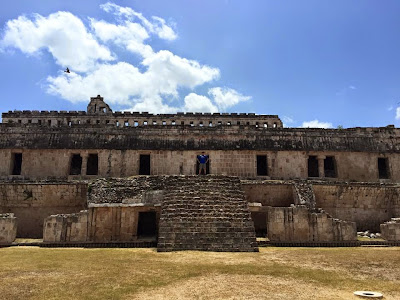An hour long flight from Mexico City and we arrived in the hottest place on earth; Merida, Mexico.
It's hot here.... as in.... scorching... High's of 100+ degrees each day...
Like, I've never experienced this kind of heat and humidity. Merida makes D.C. in the summer seem absolutely lovely by comparison.
Merida was a nice, but very quiet town, coming from Mexico City. During the 19th-20th century it was a prosperous town and that faded grandeur can be seen in the massive Colonial-style mansions that line the broad avenues. Since we arrived midday, we had time to kill and nothing planed, so Sean, Candace, and I wandered downtown to the historical center and plaza mayor to check out the area and find somewhere for lunch.
Having arrived on a Sunday afternoon made finding an open restaurant some what challenging. (One of the first lessons I learned, the hard way, as a newbie to Latin American culture is that one shouldn't plan to do much of anything on a Sunday, especially not going out to eat. Unless you live near a very thriving tourist area; like Miraflores). We finally found a nice little restaurant to eat at. And we got to try some of the local cuisine. Tacos de canzon (dogfish tacos) for me, cochinita pibil (pork cooking in banana leaves), and pollo poc chic (essentially grilled chicken). The food was good, but nothing compared to the delicious meals we had eaten back in Mexico City.
Also, as part of this day trip we were able to visit Kabah, a site just south of Uxmal. There is a raised pedestrian causeway that connects the two places (however, we were kinda lazy and didn't walk the 18km, we were driven). Kabah features a famous structure that is covered entirely in hundreds of stone masks dedicated to the rain god Chaac.
 |
| the ball court and Sean climbing different things |
Day Two: On our last full day in the Yucatan we got up bright and early yet again to head farther out to visit Chichen Itza. Chichen Itza is the most famous and most well preserved of all of the Maya pyramids on the Yucatan, and thus it is the most tourist-y and most visited. Our guide for the day told us that approximately 5,000 people visit Chichen Itza every day. Chichen Itza was named a UNESCO World Heritage site in 1988.
 |
| side view of Chichen Itza (with no people around!) |
The whole site is remarkably well preserved, if not a little commercialized. The ambiance of the whole experience was detracted from (in my opinion) by the hundreds of vendors that lined the paths that wound among the ruins and the vendors who were walking around hawking their wares (Not that that stopped me from buying post cards). I just felt that the vendors should maybe be kept out of the central part of Chichen Itza since the place got really crowded by midday when it was filled with tons of tourists and tons of vendors. Never the less visiting Chichen Itza, Uxmal, and Kabah was a once in a lifetime experience that I am supremely grateful that I was able to have.
 |
| obligatory tourist photo with the pyramid |
 |
| detail of a feathered serpent at the steps to the Skull Platform |
 |
| there were sun-drunk iguanas lounging everywhere, this one let me get with in a foot of it before it scrambled away |
 |
| one last view of Chichen Itza |
Aside from seeing thousands of years old ruins of epic proportions, which is a really cool thing on its own, we also had the opportunity to go swimming in the cenote Ik Kil near Chichen Itza. Cenotes, which dot Mexico's Yucatan Peninsula, are sinkholes that were formed in the Peninsulas porous limestone bedrock and are filled with natural mineral rich fresh water. Cenotes were considered sacred by the Mayans because they were the only source of potable water in a region that would go through serious dry seasons and it was thought to be a place where one could communicate with the gods. Today these cenotes are still cared for by Mayan women, who maintain each cenote as an eco-park. There is a 70 MX peso fee to get in, but it is definitely worth it to experience this unique experience in an idyllic setting. Plus, it was a great way to cool off and get refreshed after a hot, sweaty day walking around in the full sun and 100 degree heat.
And thus ended our trip to Mexico! We had a fantastic time exploring this country. It was really such a pleasant surprise that we enjoyed both Mexico City and the Yucatan so much. And we definitely want to go back in the future.
Next stop the Dominican Republic!










No comments :
Post a Comment